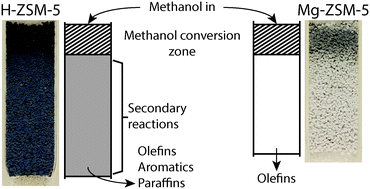当前位置:
X-MOL 学术
›
Catal. Sci. Technol.
›
论文详情
Our official English website, www.x-mol.net, welcomes your
feedback! (Note: you will need to create a separate account there.)
Spatiotemporal coke formation over zeolite ZSM-5 during the methanol-to-olefins process as studied with operando UV-vis spectroscopy: a comparison between H-ZSM-5 and Mg-ZSM-5†
Catalysis Science & Technology ( IF 4.4 ) Pub Date : 2018-02-26 00:00:00 , DOI: 10.1039/c7cy02459b Joris Goetze 1, 2, 3, 4, 5 , Bert M. Weckhuysen 1, 2, 3, 4, 5
Catalysis Science & Technology ( IF 4.4 ) Pub Date : 2018-02-26 00:00:00 , DOI: 10.1039/c7cy02459b Joris Goetze 1, 2, 3, 4, 5 , Bert M. Weckhuysen 1, 2, 3, 4, 5
Affiliation

|
In this work, during the methanol-to-olefins (MTO) reaction, the formation of hydrocarbon pool species as well as the accumulation of coke and coke precursor molecules were monitored with operando UV-vis spectroscopy. Using three UV-vis probes at different positions along the reactor bed simultaneously, the formation of active species and coke along the reactor bed was measured. Two catalyst materials have been compared with this operando approach: H-ZSM-5 with a Si/Al ratio of 50; and the same zeolite material that was modified using magnesium. It was revealed using spatiotemporal UV-vis spectroscopy that for both H-ZSM-5 and Mg-ZSM-5 a coke front is formed in the beginning of the reactor bed, and this coke front travels through the catalyst bed. Once the coke front reaches the end of the bed, deactivation of the catalyst material is observed. The magnesium modification resulted in extended lifetime of the catalyst, as well as higher selectivity towards olefins compared to H-ZSM-5. Operando UV-vis spectroscopy data revealed that the increase in lifetime of the catalyst was accompanied by a slower progression of the coke front through the catalyst bed, and less formation of aromatic species, especially in the parts of the catalyst bed behind the methanol conversion zone, i.e., behind the coke front. Additional experiments where MTO products, i.e., ethylene and propylene, were fed to the reactor, showed that the formation of aromatic species behind the methanol conversion zone on H-ZSM-5 are the result of aromatization of the products of methanol conversion, such as ethylene and propylene. On Mg-ZSM-5, however, ethylene and propylene were less reactive, resulting in less aromatics formation and a higher selectivity towards olefins. Based on these results, a distinction was made between primary coke, i.e., coke that forms due to the conversion of methanol into hydrocarbons, and secondary coke, i.e. coke that is formed when the MTO products, such as propylene and ethylene, undergo subsequent aromatization further in the reactor bed. The reason for the observed differences between H-ZSM-5 and Mg-ZSM-5 is that the Mg-modification results in a decrease in the number of Brønsted acid sites, as well as the creation of Lewis acid sites. The decrease in Brønsted acid sites limits the formation of secondary coke that is caused by olefin aromatization. This in turn leads to the increased lifetime and higher observed olefin selectivity of Mg-ZSM-5 relative to H-ZSM-5.
中文翻译:

用操作紫外可见光谱研究的甲醇制烯烃过程中,沸石ZSM-5上时空焦炭的形成:H-ZSM-5和Mg-ZSM-5的比较†
在这项工作中,在甲醇制烯烃(MTO)反应期间,使用操作紫外可见光谱法监测烃库物质的形成以及焦炭和焦炭前体分子的积累。同时在沿反应器床的不同位置使用三个紫外可见探针,测量沿反应器床的活性物质和焦炭的形成。已将两种催化剂材料与此操作进行了比较方法:H-ZSM-5,Si / Al比为50;和使用镁改性的相同沸石材料。使用时空紫外-可见光谱法揭示出,对于H-ZSM-5和Mg-ZSM-5而言,在反应器床的开始处都形成了焦炭前沿,并且该焦炭前沿穿过催化剂床。一旦焦炭前沿到达床的末端,就观察到催化剂材料的失活。与H-ZSM-5相比,镁的改性延长了催化剂的使用寿命,并提高了对烯烃的选择性。Operando紫外可见光谱数据表明,催化剂寿命的增加伴随着焦炭前锋通过催化剂床层的进展较慢,且形成的芳香族物种较少,尤其是在甲醇转化区后面的催化剂床层中,即,在焦炭前部的后面。MTO产品的其他实验,即乙烯和丙烯进料到反应器中,表明H-ZSM-5上甲醇转化区后面的芳族物质的形成是甲醇转化产物(如乙烯和丙烯)芳构化的结果。但是,在Mg-ZSM-5上,乙烯和丙烯的反应性较低,导致形成较少的芳族化合物,并且对烯烃的选择性更高。基于这些结果,区分了一级焦炭(即由于甲醇转化为碳氢化合物而形成的焦炭)和二级焦炭(即,因甲醇转化为碳氢化合物而形成的焦炭)。当MTO产品(例如丙烯和乙烯)在反应器床层中进一步进行后续芳构化时形成的焦炭。在H-ZSM-5和Mg-ZSM-5之间观察到差异的原因是,Mg改性导致布朗斯台德酸性位点数量减少以及路易斯酸位点的产生。布朗斯台德酸位的减少限制了由烯烃芳构化引起的二次焦炭的形成。这继而导致相对于H-ZSM-5,Mg-ZSM-5的使用寿命增加,并且观察到的烯烃选择性更高。
更新日期:2018-02-26
中文翻译:

用操作紫外可见光谱研究的甲醇制烯烃过程中,沸石ZSM-5上时空焦炭的形成:H-ZSM-5和Mg-ZSM-5的比较†
在这项工作中,在甲醇制烯烃(MTO)反应期间,使用操作紫外可见光谱法监测烃库物质的形成以及焦炭和焦炭前体分子的积累。同时在沿反应器床的不同位置使用三个紫外可见探针,测量沿反应器床的活性物质和焦炭的形成。已将两种催化剂材料与此操作进行了比较方法:H-ZSM-5,Si / Al比为50;和使用镁改性的相同沸石材料。使用时空紫外-可见光谱法揭示出,对于H-ZSM-5和Mg-ZSM-5而言,在反应器床的开始处都形成了焦炭前沿,并且该焦炭前沿穿过催化剂床。一旦焦炭前沿到达床的末端,就观察到催化剂材料的失活。与H-ZSM-5相比,镁的改性延长了催化剂的使用寿命,并提高了对烯烃的选择性。Operando紫外可见光谱数据表明,催化剂寿命的增加伴随着焦炭前锋通过催化剂床层的进展较慢,且形成的芳香族物种较少,尤其是在甲醇转化区后面的催化剂床层中,即,在焦炭前部的后面。MTO产品的其他实验,即乙烯和丙烯进料到反应器中,表明H-ZSM-5上甲醇转化区后面的芳族物质的形成是甲醇转化产物(如乙烯和丙烯)芳构化的结果。但是,在Mg-ZSM-5上,乙烯和丙烯的反应性较低,导致形成较少的芳族化合物,并且对烯烃的选择性更高。基于这些结果,区分了一级焦炭(即由于甲醇转化为碳氢化合物而形成的焦炭)和二级焦炭(即,因甲醇转化为碳氢化合物而形成的焦炭)。当MTO产品(例如丙烯和乙烯)在反应器床层中进一步进行后续芳构化时形成的焦炭。在H-ZSM-5和Mg-ZSM-5之间观察到差异的原因是,Mg改性导致布朗斯台德酸性位点数量减少以及路易斯酸位点的产生。布朗斯台德酸位的减少限制了由烯烃芳构化引起的二次焦炭的形成。这继而导致相对于H-ZSM-5,Mg-ZSM-5的使用寿命增加,并且观察到的烯烃选择性更高。











































 京公网安备 11010802027423号
京公网安备 11010802027423号